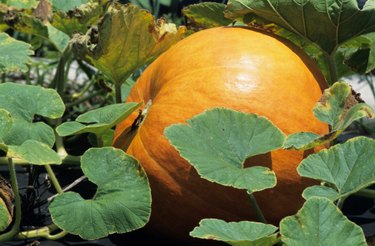
Americans tend to call any orange-colored gourd or squash a pumpkin. In fact, pumpkins can grow from any of three species: Cucurbita maxima, Cucurbita pepo and Curcurbita moschata. Regardless of species, pumpkin vines sprawl across the garden soil and need lots of sunlight to grow well, bloom and then produce fruit. Pumpkins are intolerant of frost, so plant pumpkin seeds in late spring to midsummer, when temperatures are warm and tropical. Ideally, you should time the planting so that pumpkins are ready for harvest from the beginning to the middle of October.
Plant Longevity
Video of the Day
Pumpkins are annual plants. The seeds sprout, grow into mature plants, bloom and produce fruit in one growing season that lasts between 80 and 120 days, depending on variety. Once the fruit matures fully and the seeds inside them are ripe, the pumpkin plant dies. Fall frost also kills pumpkin plants, regardless of their age. Pumpkins are replanted each year in gardens to produce a new crop.
Video of the Day
Pumpkin Ripening
It's important to monitor the development of pumpkins on the vine in a garden or field. When the immature pumpkins are still green and enlarging, there's still lots of further growth needed. Once the green skin begins changing to yellow stripes and eventually turns orange, they will be ready for harvest within two to four weeks. Pluck pumpkins from the vine only once the rind is hard and the skin is a full, deep orange. Once ripe, pumpkins will begin to decompose within one month if temperatures are still warm in the garden. Frosts and freezes also can damage pumpkin fruit tissues that cause rot.
Harvesting
Cut pumpkins from the vine so that a stem stump 3 to 4 inches long remains on the top of the pumpkin. Lifting pumpkins by the stem often causes the stem to rip the top of the pumpkin completely off. Stemless pumpkins rot more quickly, since pathogens penetrate through the wound and thin tissues at the top of the pumpkin. Any pumpkins lacking a stem should be used before stemmed fruits, which are most likely to store well for several months. Bruised fruit and immature pumpkins are not worth harvesting for long-term storage or display.
Storing Pumpkins
Harvested pumpkins have a long shelf life when placed in a cool, dry area. Humidity shortens storage lifespan, and shelf life also decreases as temperature increases. Ripe, unblemished pumpkins last for up to three months if in a room that's between 50 and 55 degrees Fahrenheit. If you place pumpkins in average humidity of 50 to 60 percent in cool room at 45 to 50 degrees, they can be stored for three to six months. Never refrigerate pumpkins, as the temperature is too cool and humidity inside the refrigerator is often too high. Overly dry rooms can dehydrate and prematurely shrivel pumpkins. Do not store pumpkins with apples, as ethylene released by apples shortens pumpkin shelf life.
- University of Illinois Extension; Pumpkin; Ron Wolford and Drusilla Banks
- University of Illinois Extension; Harvesting and Storing Pumpkins, Winter Squash, and Gourds; Maurice Ogutu
- North Carolina Cooperative Extension Service; Storing Winter Squash and Pumpkins; Jonathan R. Schultheis and Charles W. Averre; January 1998
- Learn2Grow: Cucurbita Moschata
- Learn2Grow: Cucurbita Maxima